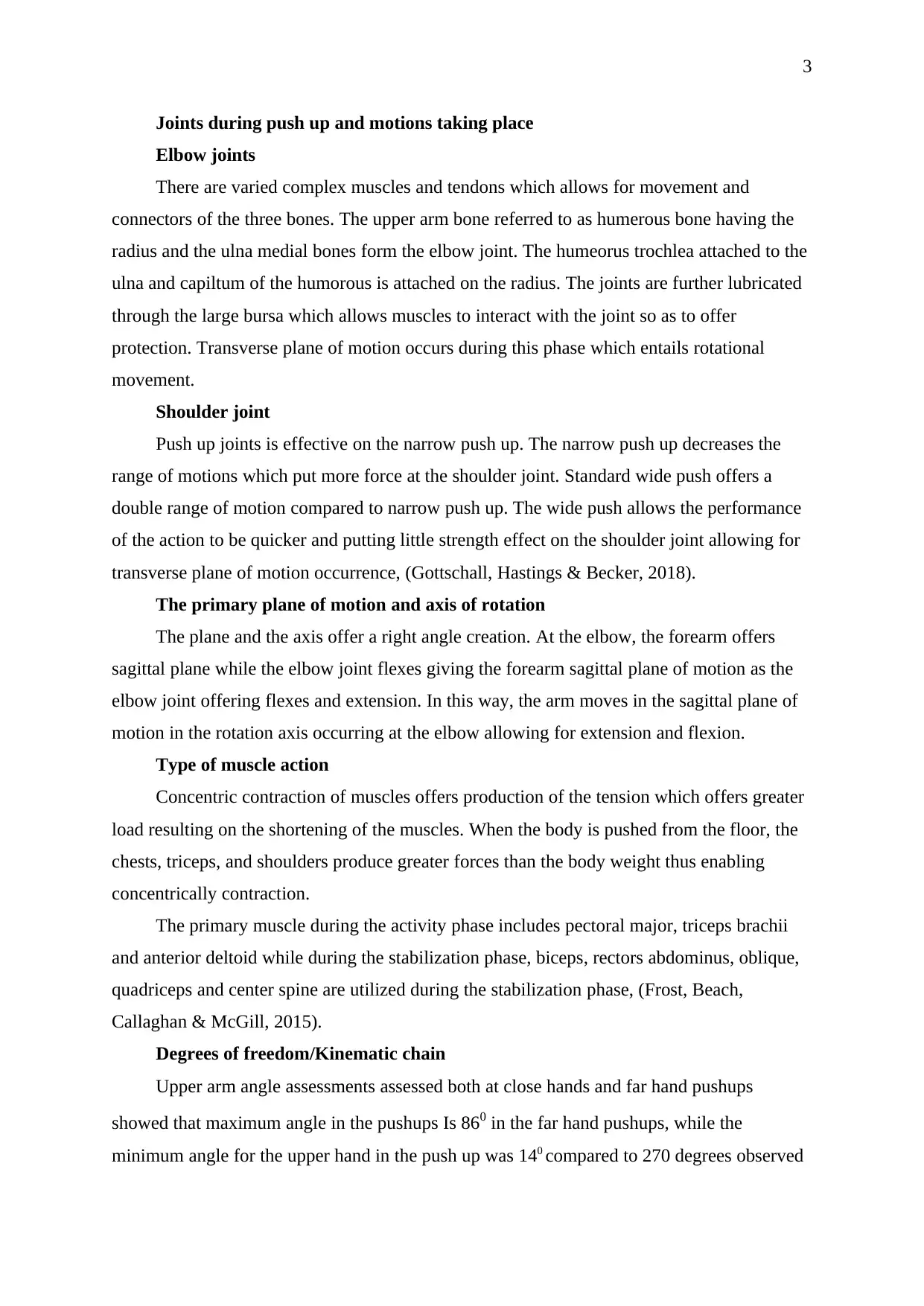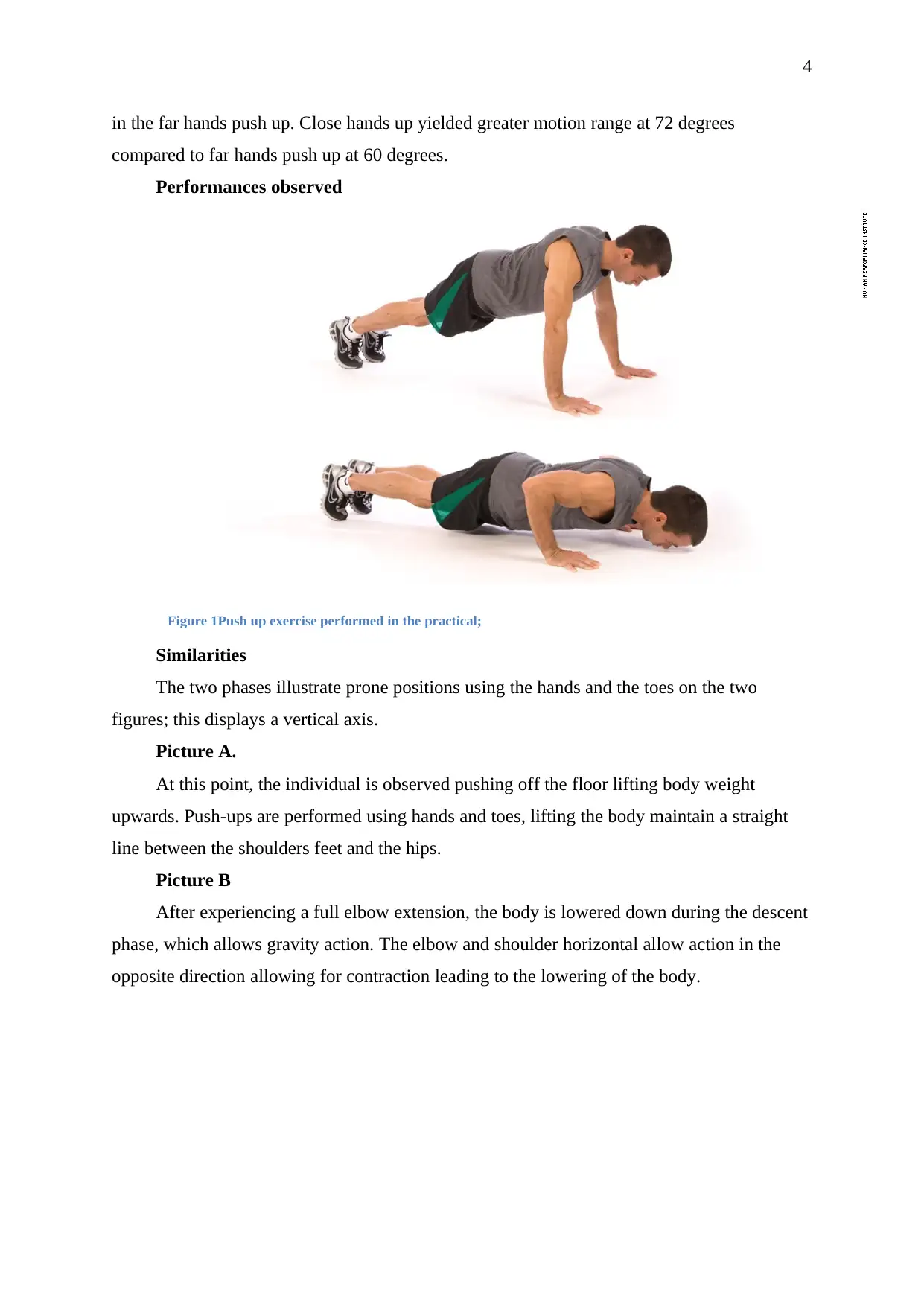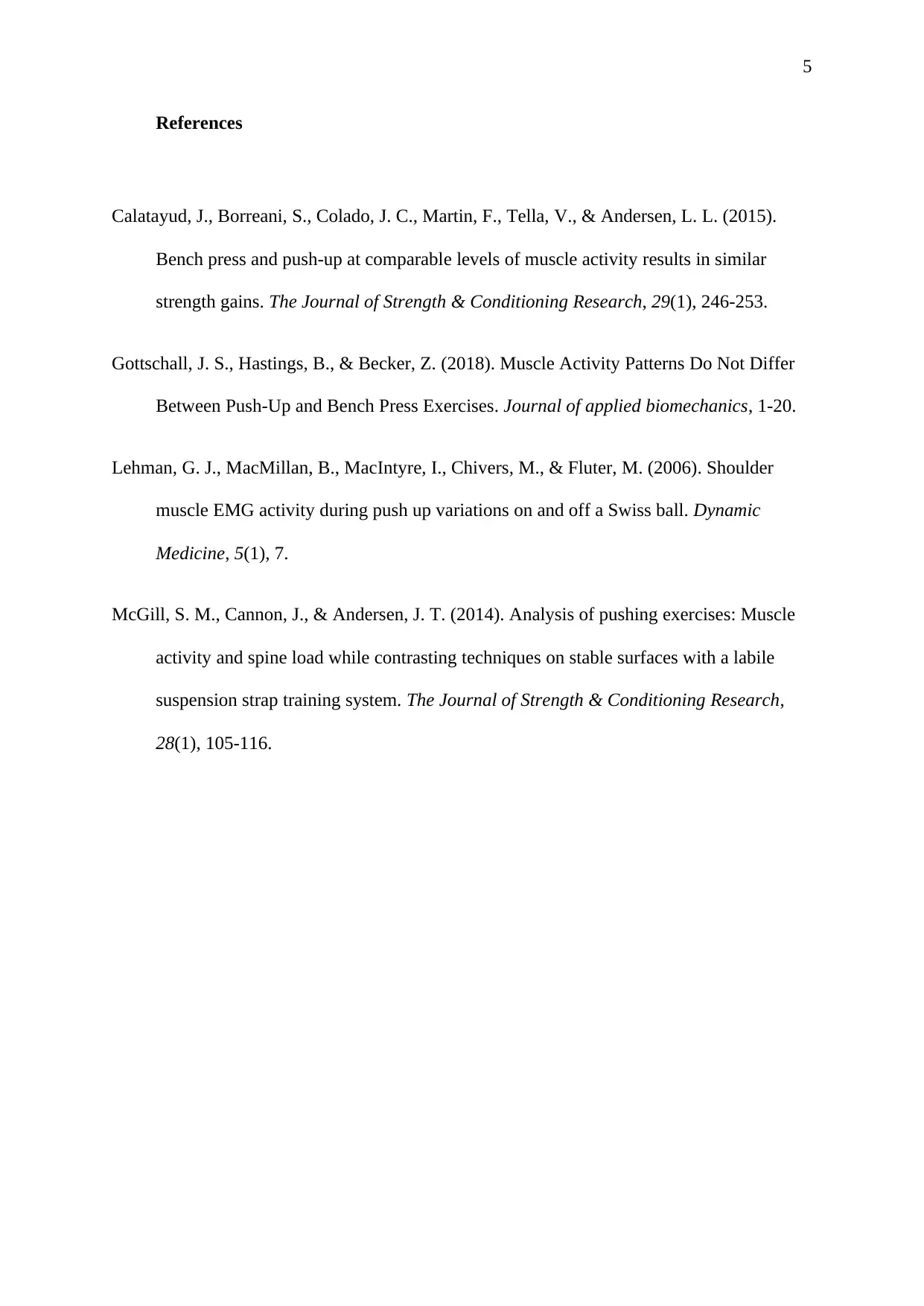Qualitative Push-Up Exercise Analysis: Applied Bioscience Unit 365
VerifiedAdded on 2023/05/31
|5
|1243
|298
Practical Assignment
AI Summary
This assignment provides a qualitative analysis of the push-up exercise, breaking it down into temporal phases (ascent and descent) and discrete events. It identifies the goal of the activity, key muscle actions (concentric contraction), and the joints involved (elbow and shoulder), detailing the motions ...

UNIVERSITY
Unit
Applied Bioscience 365
Task
Push up exercise analysis
Tutor
Unit
Applied Bioscience 365
Task
Push up exercise analysis
Tutor
Paraphrase This Document
Need a fresh take? Get an instant paraphrase of this document with our AI Paraphraser

2
Push up exercise activity analysis
The goal of the activity
The goal of this exercise is to establish the push-up exercises involved during exercise
activity.
Temporal phases of push up
During the temporal assessment, movement on the cycle occurs in the down position
which ensures the flexibility of the elbow and abduction of the shoulders, which is extended
in the upward direction to peak position allowing the extension of the elbow abducted
horizontally, (McGill, Cannon & Anderson, 2014; Lehman, MacMillan, MacIntyre, Chivers
& Fluter, 2006).).
The push up hands using the close hands' method was longer compared to far hand
push up with 1.82 seconds and 1.02 seconds respectively. These movements are further
divided into two discrete pauses; ascent and descent phase. Ascent phase entails movement
from starting position to the peak position during the push-up activity. Ascent phases took
0.83 seconds amounting to 46% of total time. For the far hands push up, it lasted for 0.43
seconds accounting for 42% of total movement time.
The descent time phase during the push-up peak position took 0.99 seconds accounting
for 54% of total time movement while for the far hands push lasted for 0.59 seconds which
accounted for 58% of total time. Key observation noted was that the ascent phase took more
time during the loose hands push up while the descent phase took less time. Generally, more
time was spent during the descending phase as compared to the ascending phase.
Discrete events
Push-ups are often performed with the support of the hands and toes in prone position
aimed at supporting the body weight. Pushing is done on the floor while the hands light the
body, which maintains straight lines between the bodies in the ascent phase which maintains
a straight line between the shoulders, hips and the feet.
Key components of the movements entail the use of elbow and the horizontal abduction
occurring at the shoulder. During the push-ups, horizontal abductors and elbow are active. In
the ascent phase, the muscles work in unison work together to produce elbow extension and
horizontal adduction processes. In the descent phase, gravity plays a crucial role in working
in the same direction. The gravity applies flexor torque on the elbow side and on the
horizontal abductor side, the muscles are applied in the opposite directions. The elbow
extensions and shoulder horizontal contract producing controlled body lowering, (Calatayud
et al., 2015).
Push up exercise activity analysis
The goal of the activity
The goal of this exercise is to establish the push-up exercises involved during exercise
activity.
Temporal phases of push up
During the temporal assessment, movement on the cycle occurs in the down position
which ensures the flexibility of the elbow and abduction of the shoulders, which is extended
in the upward direction to peak position allowing the extension of the elbow abducted
horizontally, (McGill, Cannon & Anderson, 2014; Lehman, MacMillan, MacIntyre, Chivers
& Fluter, 2006).).
The push up hands using the close hands' method was longer compared to far hand
push up with 1.82 seconds and 1.02 seconds respectively. These movements are further
divided into two discrete pauses; ascent and descent phase. Ascent phase entails movement
from starting position to the peak position during the push-up activity. Ascent phases took
0.83 seconds amounting to 46% of total time. For the far hands push up, it lasted for 0.43
seconds accounting for 42% of total movement time.
The descent time phase during the push-up peak position took 0.99 seconds accounting
for 54% of total time movement while for the far hands push lasted for 0.59 seconds which
accounted for 58% of total time. Key observation noted was that the ascent phase took more
time during the loose hands push up while the descent phase took less time. Generally, more
time was spent during the descending phase as compared to the ascending phase.
Discrete events
Push-ups are often performed with the support of the hands and toes in prone position
aimed at supporting the body weight. Pushing is done on the floor while the hands light the
body, which maintains straight lines between the bodies in the ascent phase which maintains
a straight line between the shoulders, hips and the feet.
Key components of the movements entail the use of elbow and the horizontal abduction
occurring at the shoulder. During the push-ups, horizontal abductors and elbow are active. In
the ascent phase, the muscles work in unison work together to produce elbow extension and
horizontal adduction processes. In the descent phase, gravity plays a crucial role in working
in the same direction. The gravity applies flexor torque on the elbow side and on the
horizontal abductor side, the muscles are applied in the opposite directions. The elbow
extensions and shoulder horizontal contract producing controlled body lowering, (Calatayud
et al., 2015).

3
Joints during push up and motions taking place
Elbow joints
There are varied complex muscles and tendons which allows for movement and
connectors of the three bones. The upper arm bone referred to as humerous bone having the
radius and the ulna medial bones form the elbow joint. The humeorus trochlea attached to the
ulna and capiltum of the humorous is attached on the radius. The joints are further lubricated
through the large bursa which allows muscles to interact with the joint so as to offer
protection. Transverse plane of motion occurs during this phase which entails rotational
movement.
Shoulder joint
Push up joints is effective on the narrow push up. The narrow push up decreases the
range of motions which put more force at the shoulder joint. Standard wide push offers a
double range of motion compared to narrow push up. The wide push allows the performance
of the action to be quicker and putting little strength effect on the shoulder joint allowing for
transverse plane of motion occurrence, (Gottschall, Hastings & Becker, 2018).
The primary plane of motion and axis of rotation
The plane and the axis offer a right angle creation. At the elbow, the forearm offers
sagittal plane while the elbow joint flexes giving the forearm sagittal plane of motion as the
elbow joint offering flexes and extension. In this way, the arm moves in the sagittal plane of
motion in the rotation axis occurring at the elbow allowing for extension and flexion.
Type of muscle action
Concentric contraction of muscles offers production of the tension which offers greater
load resulting on the shortening of the muscles. When the body is pushed from the floor, the
chests, triceps, and shoulders produce greater forces than the body weight thus enabling
concentrically contraction.
The primary muscle during the activity phase includes pectoral major, triceps brachii
and anterior deltoid while during the stabilization phase, biceps, rectors abdominus, oblique,
quadriceps and center spine are utilized during the stabilization phase, (Frost, Beach,
Callaghan & McGill, 2015).
Degrees of freedom/Kinematic chain
Upper arm angle assessments assessed both at close hands and far hand pushups
showed that maximum angle in the pushups Is 860 in the far hand pushups, while the
minimum angle for the upper hand in the push up was 140 compared to 270 degrees observed
Joints during push up and motions taking place
Elbow joints
There are varied complex muscles and tendons which allows for movement and
connectors of the three bones. The upper arm bone referred to as humerous bone having the
radius and the ulna medial bones form the elbow joint. The humeorus trochlea attached to the
ulna and capiltum of the humorous is attached on the radius. The joints are further lubricated
through the large bursa which allows muscles to interact with the joint so as to offer
protection. Transverse plane of motion occurs during this phase which entails rotational
movement.
Shoulder joint
Push up joints is effective on the narrow push up. The narrow push up decreases the
range of motions which put more force at the shoulder joint. Standard wide push offers a
double range of motion compared to narrow push up. The wide push allows the performance
of the action to be quicker and putting little strength effect on the shoulder joint allowing for
transverse plane of motion occurrence, (Gottschall, Hastings & Becker, 2018).
The primary plane of motion and axis of rotation
The plane and the axis offer a right angle creation. At the elbow, the forearm offers
sagittal plane while the elbow joint flexes giving the forearm sagittal plane of motion as the
elbow joint offering flexes and extension. In this way, the arm moves in the sagittal plane of
motion in the rotation axis occurring at the elbow allowing for extension and flexion.
Type of muscle action
Concentric contraction of muscles offers production of the tension which offers greater
load resulting on the shortening of the muscles. When the body is pushed from the floor, the
chests, triceps, and shoulders produce greater forces than the body weight thus enabling
concentrically contraction.
The primary muscle during the activity phase includes pectoral major, triceps brachii
and anterior deltoid while during the stabilization phase, biceps, rectors abdominus, oblique,
quadriceps and center spine are utilized during the stabilization phase, (Frost, Beach,
Callaghan & McGill, 2015).
Degrees of freedom/Kinematic chain
Upper arm angle assessments assessed both at close hands and far hand pushups
showed that maximum angle in the pushups Is 860 in the far hand pushups, while the
minimum angle for the upper hand in the push up was 140 compared to 270 degrees observed
⊘ This is a preview!⊘
Do you want full access?
Subscribe today to unlock all pages.

Trusted by 1+ million students worldwide

4
in the far hands push up. Close hands up yielded greater motion range at 72 degrees
compared to far hands push up at 60 degrees.
Performances observed
Figure 1Push up exercise performed in the practical;
Similarities
The two phases illustrate prone positions using the hands and the toes on the two
figures; this displays a vertical axis.
Picture A.
At this point, the individual is observed pushing off the floor lifting body weight
upwards. Push-ups are performed using hands and toes, lifting the body maintain a straight
line between the shoulders feet and the hips.
Picture B
After experiencing a full elbow extension, the body is lowered down during the descent
phase, which allows gravity action. The elbow and shoulder horizontal allow action in the
opposite direction allowing for contraction leading to the lowering of the body.
in the far hands push up. Close hands up yielded greater motion range at 72 degrees
compared to far hands push up at 60 degrees.
Performances observed
Figure 1Push up exercise performed in the practical;
Similarities
The two phases illustrate prone positions using the hands and the toes on the two
figures; this displays a vertical axis.
Picture A.
At this point, the individual is observed pushing off the floor lifting body weight
upwards. Push-ups are performed using hands and toes, lifting the body maintain a straight
line between the shoulders feet and the hips.
Picture B
After experiencing a full elbow extension, the body is lowered down during the descent
phase, which allows gravity action. The elbow and shoulder horizontal allow action in the
opposite direction allowing for contraction leading to the lowering of the body.
Paraphrase This Document
Need a fresh take? Get an instant paraphrase of this document with our AI Paraphraser

5
References
Calatayud, J., Borreani, S., Colado, J. C., Martin, F., Tella, V., & Andersen, L. L. (2015).
Bench press and push-up at comparable levels of muscle activity results in similar
strength gains. The Journal of Strength & Conditioning Research, 29(1), 246-253.
Gottschall, J. S., Hastings, B., & Becker, Z. (2018). Muscle Activity Patterns Do Not Differ
Between Push-Up and Bench Press Exercises. Journal of applied biomechanics, 1-20.
Lehman, G. J., MacMillan, B., MacIntyre, I., Chivers, M., & Fluter, M. (2006). Shoulder
muscle EMG activity during push up variations on and off a Swiss ball. Dynamic
Medicine, 5(1), 7.
McGill, S. M., Cannon, J., & Andersen, J. T. (2014). Analysis of pushing exercises: Muscle
activity and spine load while contrasting techniques on stable surfaces with a labile
suspension strap training system. The Journal of Strength & Conditioning Research,
28(1), 105-116.
References
Calatayud, J., Borreani, S., Colado, J. C., Martin, F., Tella, V., & Andersen, L. L. (2015).
Bench press and push-up at comparable levels of muscle activity results in similar
strength gains. The Journal of Strength & Conditioning Research, 29(1), 246-253.
Gottschall, J. S., Hastings, B., & Becker, Z. (2018). Muscle Activity Patterns Do Not Differ
Between Push-Up and Bench Press Exercises. Journal of applied biomechanics, 1-20.
Lehman, G. J., MacMillan, B., MacIntyre, I., Chivers, M., & Fluter, M. (2006). Shoulder
muscle EMG activity during push up variations on and off a Swiss ball. Dynamic
Medicine, 5(1), 7.
McGill, S. M., Cannon, J., & Andersen, J. T. (2014). Analysis of pushing exercises: Muscle
activity and spine load while contrasting techniques on stable surfaces with a labile
suspension strap training system. The Journal of Strength & Conditioning Research,
28(1), 105-116.
1 out of 5
Your All-in-One AI-Powered Toolkit for Academic Success.
+13062052269
info@desklib.com
Available 24*7 on WhatsApp / Email
![[object Object]](/_next/static/media/star-bottom.7253800d.svg)
Unlock your academic potential
© 2024 | Zucol Services PVT LTD | All rights reserved.


